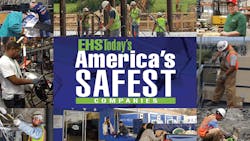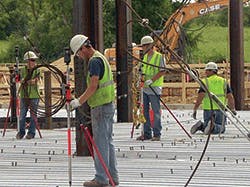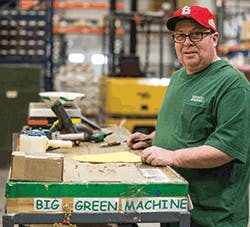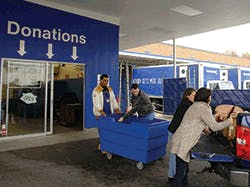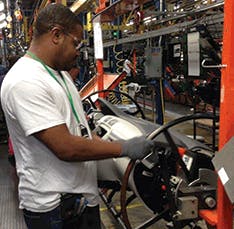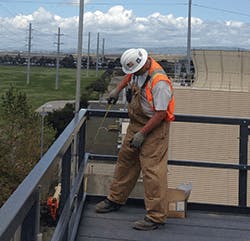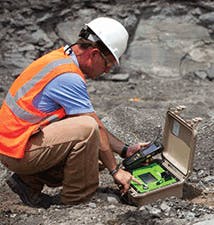America's Safest Companies Winners: Egan Company, Field Fastener, Goodwill Industries of Upstate/Midlands South Carolina, Inteva Products, Kirk Erectors Inc., and Orica USA Inc.
Egan Company
Like many safety-minded organizations, Brooklyn Park, Minn.-based specialty contractor Egan Co. subscribes to the notion that all accidents and injuries are preventable. So when Minnesota authorities determined that there was nothing the company could've done to prevent a roadway work-zone accident in which a motorist struck and killed two Egan employees in October 2011, the company refused to accept the theory that such tragedies are inevitable.
Instead, Egan – along with the Associated General Contractors of Minnesota and the victim's families – helped champion the first major change to Minnesota's work-zone safety regulations in 15 years. The new law, which took effect Aug. 1, established a minimum $300 fine for speeding in work zones and for ignoring work-zone flaggers' traffic directions, and lowered the speed limit in active construction zones to 45 mph. The law also mandated that transportation authorities post signs clearly stating that work-zone infractions are punishable by a $300 fine, replacing the ambiguous signs that said "fines will be doubled."
Safety is a "top-to-bottom cultural priority" at Egan. Malecha and other executives conduct at least one safety audit of a job site each month, and senior leaders serve on the company's incident-review committee. Field employees from various construction groups serve on the safety committee, and all employees have stop-work authority if they observe unsafe conditions.
Every day on every Egan job site, the foremen and crews meet and complete a daily safety plan. During the planning process, they discuss the previous day's safety performance, the work on today's docket and how they plan to approach today's work safely.
Egan Co. —
Brooklyn Park, Minn.
950 employees/sites across Minnesota and Wisconsin/4 EHS professionals
Egan encourages safe activities and behavior by offering "safety bucks," which are redeemable for merchandise in the company store. Employees earn safety bucks for participating in training sessions, submitting safety suggestions and reporting near-misses, and for individual and corporate safety milestones. All corporate officers and group managers also carry safety bucks to provide an on-the-spot reward for safe behavior.
Field Fastener
Field Fastener specializes in the warehousing and distribution of fasteners and other Class C commodities. It also specializes in providing those services safely.
Material handling is at the heart of much of the company's work, and Field has gone to great lengths to minimize the risk of lifting, carrying and bending injuries to its employees. Rollers help move cartons and skids, while a motorized conveyor transports material from the second-floor storage area to the main level of its facility in Machesney Park, Ill.
Field recognizes the business imperative for safety. Potential customers often ask about the company's EHS performance. And as a small company with lean operations, Field needs "to be able to count on each team member to perform his or her role at the highest level," explains Timothy Firm, Field's HR director.
"Injuries and illnesses can place a hardship on our ability to meet our customers' needs if we have people unable to perform their duties because of injury or unwilling to perform their duties because of unsafe conditions," Firm says.
Field Fastener —
Machesney Park, Ill.
74 employees/1 EHS professional
That's hardly ever the case. As of early October, Field's lost-time injury rate was zero, and the company had made it more than two years without a recordable injury.
According to Firm, other keys to the company's EHS success include its peer-to-peer "Field Rocks!" recognition program; its volunteer-driven safety team, which conducts safety audits and promotes safety throughout the company; monthly all-team meetings that address Field's safety performance; and its on-site fitness center and annual wellness fair.
"Our culture supports safety because our culture is all about the significance of each individual team member," Firm says. "As a result, we don't emphasize safety because we have to, but because it is what's best for the well-being of all."
Goodwill Industries of Upstate/Midlands South Carolina
Goodwill Industries of Upstate/Midlands South Carolina (GIUMSC) is the second retail operation to achieve America's Safest Companies status. The organization, which employees 900 associates at 38 sites, also includes intrastate transportation and rehabilitation services.
Everyone from senior leadership to store associates is involved in the safety process, and the company values and management philosophy are demonstrated with one word: "CARES," which stands for commitment, accountability, respect, excellence and stewardship.
"We use this philosophy to strengthen our core values based on our safety system," he adds. "Our associates are committed to working safely every day; we are all held accountable for our own actions; we respect each other and their safety; we strive for excellence in safety; and we are good stewards for the company."
Each associate, at some point in the year, will be responsible for the daily, five-minute safety talk held at each facility. One associate shares a safety topic with the group, and a safety walkthrough of the facilities, conducted by the safety ambassador, is completed each day before the doors open for business.
Goodwill Industries of Upstate/Midlands South Carolina Used Goods Retailing, Intrastate Transportation, Rehabilitation Services — 38 sites in South Carolina 900 employees/1 EHS professional
Twice each year, seven senior leaders, including the vice presidents of human resources, retail and safety, visit each location and holds a two-hour "Road Show" presentation, which includes a discussion of profits, costs, loss prevention, mission, benefits and safety and health. There also are monthly management meetings, at which safety is a key topic, as well as bi-monthly meetings for associates that include safety topics.
"Our unique element of involving all associates daily helps strengthen this culture even further," explains Childs. "We are creating a paradigm shift that no longer do non-profit organizations dealing with the disabled or disadvantaged have to accept higher incident rates and higher workers' compensation costs as normal."
Inteva Products
Their philosophy for safety is very simple: "Every aspect to what we do at Inteva Products is required to be ‘Safe Enough for Our Families,'" says Adam Bates, MBA, global director of EHS and loss prevention at the automotive parts manufacturer. "We utilize this philosophy during design builds, but also as we continue to reach [for] world-class [safety]."
"The responsibility of each person on that chart is to ensure the person above them has the resources needed to complete their job safely."
Each month, the company holds a global EHS and loss prevention live meeting and conference call. The call collectively engages everyone on the global team – the company has 10,000 employees at 45 locations in 18 countries – and each month focuses on a different location. That selected facility leads the conference, and all locations report five leading indicators (incident investigations, safety observation tour audits, technical-specification audits, monthly safety toolbox talks and completion of required training) into the company's metric operation system. Each tier has an "all or nothing" rating of 20 points, for a total of 100.
Inteva Products Automotive Parts — Troy, Mich.
10,000+ employees at 45 locations/22 EHS professionals
"We have also implemented a numbers-to-name initiative," adds Bates. "All incidents are a name, not a number. Hand-written personal cards are written to every employee that got injured while performing work at Inteva Products. Our CEO regularly wants the names of every incident we have globally, not a number of how many."
He notes that, "What makes these elements important to our process is that it's personal. Every incident is personal to me and our process. Every incident is a failure within our system that we must correct to prevent the ultimate failure of a reoccurrence."
Kirk Erectors Inc.
At Kirk Erectors (KE) Inc., "Safety is where business and family meet … Our objective is to maintain a safety and health program that will reduce the number of injuries and illnesses to an absolute minimum. By focusing on our employees and their health and safety, we are able to achieve this goal."
Company leaders pride themselves on going "beyond the lessons learned in a book," and encourage field workers "to think critically in daily situations with the proper knowledge and experience they have gained." The goal is to learn from each situation, so that employees at every level continue to improve safety awareness. Collaboration between the safety director, president, superintendent and field staff drives the safety culture through a team atmosphere. Senior management engages daily with the field leadership, and performs scheduled and non-scheduled on-site safety visits.
Kirk Erectors Inc. Cooling Tower Design, Construction, Maintenance and Repair —
Golden, Colo. 100 employees/3 EHS professionals
Cooling tower construction is a unique industry in terms of safety challenges and advancements from the reconstruction process through new tower erection procedures. KE considers safety an integral part of quality control, cost reduction and job efficiency.
"At Kirk Erectors, we understand that accidents can be prevented through proper project planning, employee training and cooperative efforts throughout all areas of our operations by constantly striving to improve our work environment," says Nick Murer, director. "Though we believe our safety program to be very effective, we also recognize that as long as any possibility exists for even one person to suffer injury, we must continue to stress safety and to strive for improvement."
Orica USA Inc.
At Orica USA Inc., which provides commercial explosives and blasting systems to the mining and infrastructure markets, visible leadership for safety by all employees has fostered the development of a safety management system, rather than a safety program.
Orica USA Inc. — Watkins, Colo. 311 employees/57 sites/
7 EHS professionals
The company has several innovative programs, including CARE (compliance, awareness, response, evaluation), which initially was established as an internal safety rating system to track key metrics at the site level. The system ranks each site/operation against a set of known criteria, both leading and lagging. Lagging, negative indicators such as injuries, citations, overdue actions and severity of incidents contribute to the negative score. The leading, positive indicators such as training completion, safety-meeting attendance, pre-task planning-document completion, audit completion, completion of corrective actions and near-miss reporting all contribute to a positive score. The safety rating identifies areas of concern for management review and tracks compliance with the underlying SHEC requirements to ensure overall compliance with state and federal regulation and company procedures. Jones calls the overall site scores a way to track the company's "safety pulse."
"Most of our work is done on customer sites, including mines, quarries and construction sites," he notes. "There are no second chances when applying energetic materials at ever-changing locations, which means we must get safety right the first time. Orica USA management believes safety is a fundamental to our license to operate."
